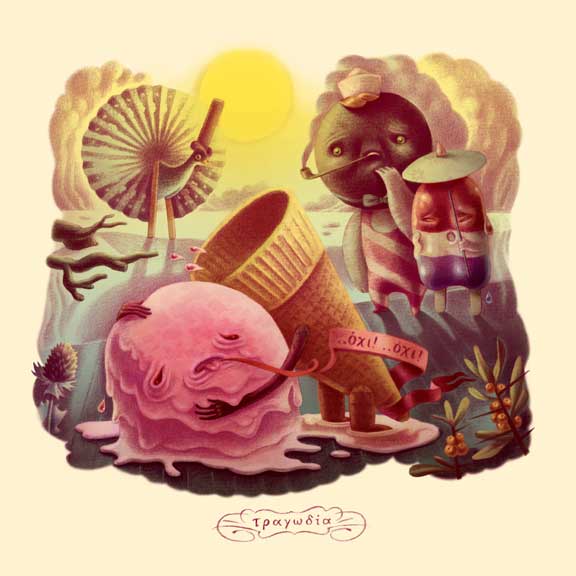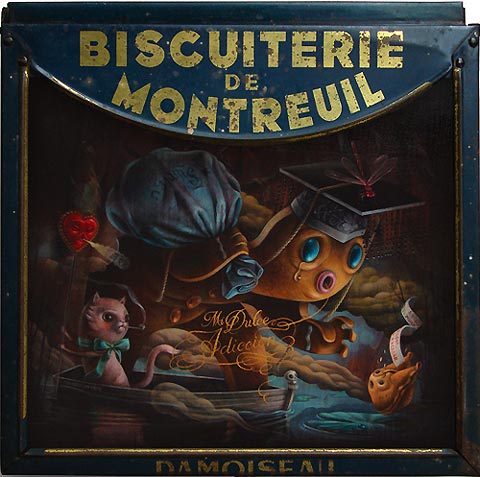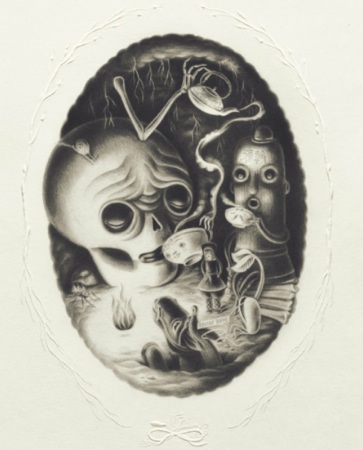Her last Amsterdam exhibition was sold out in 20 minutes. Seattle´s Roq La Rue Gallery owner and Hi-Fructose Magazine Editor at Large, Kirsten Anderson, calls her one of her favourite Pop Surrealism artists worldwide. Amsterdam based artist Femke Hiemstra is one of the most interesting, uprising contemporary art superstars these times. We met her for a chat.
Femke: I’m not precisely sure where my work would fit in the bigger picture of art. I don’t have an official background in autonomous art; I went to art school to study illustration. When I had the chance to spend my time making personal pieces I took it. I didn’t make the conscious decision to work in a certain style. My illustration work almost naturally flowed into what I create today. The switch was made out of curiosity and because I felt inspired and triggered to work autonomically.You could say my work is Lowbrow but I think a term like Pop Surrealism is more fitting. There’s also the less familiar description ‚Neo Fabulism‘ which might even be more accurate since my work can be looked at as based on narrative and anthropomorphism.
According to most fine art critics these movements are all part of the underground family, but some claim they lie in between the high and the low culture. So I guess I’m somewhere in between, and that undefined place is just fine by me.
In your work, I really like how you take something already existing, such as books, platters, old wood, old bread bins, etc, and revitalize them, bringing new life. Your work is complex but simultaneously, I want to just relax when viewing it cause I find it soothing as well. Because the themes are fun and playful, I am curious if there is an undercurrent or theme to some of your work?
Femke: There’s no intentional theme or concept that binds all my work together. If there is one, it varies from piece to piece. The fable factor is in every work, though. You mentioned creating the pieces very autonomically, so is there actual intention or is it spontaneous, or maybe a mix of both?
When talking about creating concepts and stories I think it’s a mix of both. Sometimes it falls right into my lap in a complete form like a ready-to use image and sometimes I have to work hard for it and chase an idea, or I get only bits and pieces and I have to assemble it over time.
LJOE: Perhaps you can give a little background into the psychology (meaning some of the irony, surrealistic, or subconscious thought, if any) of creating the pieces.
Femke: Creating for me is something that goes on instinct. When I switched from illustration to making personal pieces, making art, I didn’t make the conscious decision to work in a certain style or to hit a certain tone of voice. One thing flowed into the other. The use of characters, the humour and the dark tone of voice came naturally with that.
I can be inspired by simply observing animals and their behavior and making connections from that to the life of humans, or by other art or a line from a movie, or by seeing fantastical stories in every day things. For example, when I saw a paper milkshake cup lying on the pavement, I translated that into a piece about death, with a humorous twist. I imagined that this cup when it was tossed aside, i.e., when it died, went to a world in between life and death. There it was waiting to meet Hades, the god of the underworld, and was floating on the river in a boat with two coins over its eyes.
LJOE: Is there thought around the choice in mediums, and the objects that you paint on?
Femke: Working on old objects like books and antique panels started spontaneously. I was attracted by old books with their imperfections and damages and decided to use them a canvas. The books already lived a whole life and were made before I was born. Some date back to the 18th century. They fitted my stories and concepts well so I expended the idea to other unusual canvasses. Like you mentioned before, by re-using these objects I give them a new purpose and put their craftsmanship and material in a new light.
LJOE: What about the use of „multiple languages“?
Femke: That comes from a fascination for typography and lettering and the sound of certain languages. Some works benefit from —for example— French because the title pronunciation fits the atmosphere of the subject and sometimes it’s a visual choice. Like Cyrillic or Japanese, for the average westerner unreadable (including myself), are beautiful and mysterious looking fonts. Okay, with Google that mystery is something from the past, but those symbolic signs can add the perfect graphic touch to my work.

LJOE: I mentioned „fun and playful“ earlier, I was wondering about any subcontext of suggestiveness? That is, if you lean at all toward social issues (or any issues for that matter, no matter how serious or not), any tones of social/political reference at all?
Femke: Besides the use of characters and other popular visual language modernity or actuality is not really part of my work; the themes are more of a timeless kind. Battles and conflict, lost loves, taboos and cults, death and so on. I tend to lean more to the darker side of things, I’ve noticed over time.
LJOE: Do any of the images on the books fit the stories inside? Meaning do you ever paint based on the content from the actual authors or do the books serve as more the canvas?
Femke: Perhaps in the series of 50+ painted covers I have made there has been one or two inspired by the content but usually they serve as a canvas.
LJOE: There are lot of artists and even more people who follow art. It can get competitive. Followers can come and go “here today, gone tomorrow.” Do you get discouraged or does it feed into another part of your lifestyle? How do you navigate this terrain?
Femke: Personally I don’t experience that much competition from other artists. I don’t mean that in an obnoxious way of course. I do look up to and respect of what some put out there and let that motivate me but then continue to walk on my own path. Maybe it also helps that I don’t live in the center of the movement but on the other side of the ocean and that side effects like these move more or less past me.
LJOE: It is nice to see the human side of the author, painter, or illustrator. The reason for this is to get around the „art critique“ as we mentioned in the first question of this interview, being that, there is a hierarchy of elitist, whom are able to cast judgment on works of art. They usually only know the know how to judge technique and style, as they are taught to do this in school, and so we get this assessment of the work versus knowing the person behind it. As a result of this thinking, there is a huge disconnect between studio artists and art historians that is somewhat unnecessary and it leads the readers and viewers into this false world as well, perpetuating pretentiousness.
I personally would love to see a dialogue come back together between those who paint and those who study art. From my experience, there is no concrete way to talk about or analyze art without knowing who is behind the work, the time period, what is going on in the world, and even where specifically that person lives.
For example, where I live in Southern California, but specifically Riverside, California, inland from Los Angeles, is the less attractive part of California as far as marketing goes. It is not beaches, movie stars, and fast cars, but more low-income, cultural, dirty, smoggy, and desert-like. Jeff Soto, for example, is from Riverside and his paintings; depict much of his experience specifically to this region, even the small neighborhood he grew up in. As well, he has a cactus garden, and comes from a graffiti background as well as a fine art background and you see this in his work.
So not to compare or contrast you to Jeff Soto, as that was just an example I am familiar with, and also you are your own person—is there anything around this idea that you might want to open up to?
Maybe, you can leave us, the reader of this interview, who might be a variety of people, with something that shows this human side, an idea, a hobby outside of painting, regional influence?
Those of us from the U.S., might think, „Oh, she is from Holland, near Amsterdam, I was there as a tourist and people just sit around in cafe’s and drink coffee and eat sweet breads all day while they sing, dance, and talk with the forest animals“ so maybe something, for fun, that can break stereotypes/allusions as well?
Femke: Thanks for this exposition, it helps a lot. I grew up in a 1970’s row house neighborhood in the suburbs of Zaandam, a fairly large city close to Amsterdam. There were fields around the corner, ditches to build rafts for, and trees to climb in. I was a real tomboy. And when I wasn’t roaming through the fields with our family dog, in search of stone pipe heads or to pick flowers, I was at home puttering on some cardboard box playing ‚post office‘, or drawing and painting. I was always busy doing something (that never changed).
When I was a kid I thought I would become a veterinarian later in life but that idea quickly vanished when I learned a vet needs to operate on animals as well. After that I wanted to be a park ranger, then ’something with horses‘ and finally I ended up going into the direction of art. And that changed a lot.
I always thought I would stay in the town I grew up in, being close to nature and such but Art School turned that around. I grew creatively and personally it was an eye opener too. I learned to embrace change. After Art School I moved to Amsterdam and never left the city. Today flora and fauna still interests me and keeps flowing through my blood, and that is clearly visible in my artwork.
Last year I felt the need to learn something new and took on motorcycle lessons. I now drive a great all road machine. It’s a wonderful escape, just me and the bike, focusing on the road, flowing through the corners and bends.
The bike is parked just in front of my house. I live in a folksy neighborhood with a blend of residents including some ‚birds of paradise‘. When I bought the motorcycle the contact with my neighbors got closer. People stay and chat when I’m around the bike. There’s this one guy who I call Kawasaki Man, who always tells the same story about his old bike. I don’t always feel like hearing it but pretending to be busy doesn’t help, he waits until I see him and then he happily explains how he once fell on a icy road with his Kawasaki once more. Seeing the bike and me is the trigger for him I guess. It’s kind of fascinating that his story is always the same. But all in all I think it’s nice to have this connection with the folks in the street. It gives this city a small town feel.
LJOE: Awesome! Thank you Femke so much, for taking the time out of your schedule to do this interview. I really enjoyed the „small“ chat. If and when you’re in Southern California again, I will make the effort to come out and say „hi“!
Femke: I really enjoyed this! I think it was one of the most interesting interviews I did. So, thank you!
- Back to… KlangKANAL: LJOE DJ Set am 24.6.23 - Juni 15, 2023
- Nach 2 Jahren Pause: Wir sind zurück mit einem Podcast! - Dezember 24, 2022
- Corona-Geister – Bedruckte Shirts bekommen heftige Gegenreaktion - Juni 7, 2020





Pingback: Grande re-opening: KochxBos gallery opened with supershow in Amsterdam | Last Junkies On Earth